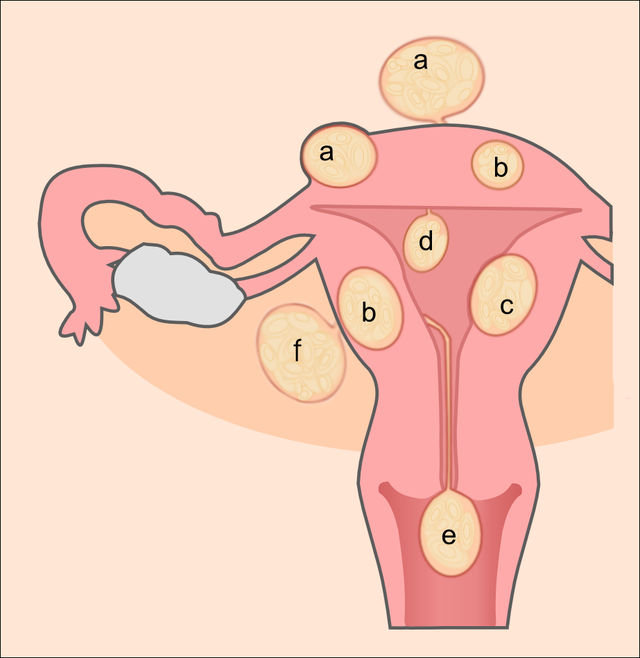I myself is not even aware that this
health condition exists until the time that my sister, aunt and a cousin were
all diagnosed with myoma, (two of them late
last year and one just recently). So I am writing about myoma not only because I was alarmed with the
incident that stricken our clan but because a lot of us women do not have enough
information about this diagnosis.
The glaring fact is, 20-50% of women of
childbearing age (biological optimal range will be 20-35 years old) may have uterine fibroids or myoma, so you might even have it already and not even aware of it yet.
 |
| Different locations of uterine fibroids |
What is Myoma?
Myoma, which is commonly known as a
fibroid, is a benign (non-cancerous) tumor that develops in or around the
uterus. It is medically termed as leiomyomas, which are tumors of the smooth
muscle (the tissue that normally makes up that wall of the uterus).
Uterine myoma can be as small as a coin for
which some women do not experience any symptoms at all but it can also increase
to a size of a melon, causing an enlarged abdomen and often times is mistaken to
be caused by gain weight or associated to pregnancy which can cause severe abdominal
pain and even difficulty in urination and sexual activities.
There can be one dominant myoma in the
uterus, or it can form into a cluster of many small myomas.
What causes Myoma?
Fibroid cause is not known yet up to this
date although it has appeared to be associated with the presence of estrogen in
the women’s body. It is during the childbearing years when a woman’s estrogen
levels are at its peak, for which fibroids can be triggered to slowly increase in
size. But during menopause when a woman’s estrogen levels are low, fibroids
rarely occur. According to research done by PubMed,” African Americans are more likely than Caucasians
to develop the disease, so as are women
who are over 30 years of age, overweight or obese, or have never given birth.”
 |
| A more detailed image of uterine fibroid locations from enzactaonlinephilippines.files.wordpress.com |
Common Symptoms of Uterine Myomas
Here are some of the common indications of
uterine myoma:
- Abnormal or even uncontrollable vaginal bleeding
- Heavy and prolonged menstrual periods
- Pain in the back of the legs
- Pelvic pain or abnormal pain
- Pain during sexual intercourse
- Myoma can grow large enough to cause pressure on the bladder which either constraints you from urinating or leads to a constant need to urinate.
- Pressure on the bowel which can lead to constipation and/or bloating
- An enlarged abdomen which may be mistaken for weight gain or pregnancy
- Dizziness, increased heart rate or even fainting
The symptoms vary. Some women who were diagnosed
may experience mild symptoms; some do not experience any symptoms at all but some,
especially with enlarged fibroids will experience extreme pain, recurring or
persistent symptoms and can even be life-threatening so they need to seek
immediate medical assistance.
Treatment for Uterine Fibroids (Myomas)
Initial
evaluation needs to be done. The doctor needs to investigate the symptoms. Your
doctor will first check the size of your uterus. If it feels enlarged, your doctor
will advise you to have an ultrasound or a magnetic resonance imaging (MRI)
session to confirm the presence, location and size of the myoma.
Depending on the medical diagnosis, the
size and the location of the fibroids, as well as factors like age, obstetric
history and (or) general health condition, and the severity of the symptoms, the
doctor will then advise what treatment can be done. It can be treated through medications (oral pain
control medications) just to alleviate the pain, the insertion of intrauterine
device to release progestin within the uterus to stop bleeding and pain, hormones
(to regulate the menstrual cycle and to reduce the symptoms) and surgical
procedures to effectively reduce, eliminate or completely remove the fibroid
out of the uterus such as:
- Hysterectomy (removal of the uterus) which is the common procedure done
- Hysteroscopic removal of the uterine fibroids using an instrument called hysteroscope which is used to visualize the endometrial cavity
- Myomectomy (surgical removal of the fibroids itself)
- Uterine artery embolization (procedure that interrupts the blood supply to fibroids)
Preventing Myoma
Prevention is always the best cure. If you
want to be cleared of myoma (fibroid) then have yourself checked. Annual
physical exam is very beneficial not only to determine if you have myoma but
also to be aware of some other health conditions such as ovarian cancer, breast cancer,
diabetes, heart issues and others. If you suspect that you have myoma, don’t
self-meditate. Seek for medical assistance. Above all, always be aware of your
food intake, your lifestyle and how you take good care of your body. Most of
the identified medical or health problems of our generation today will strike
the least that you expect them. So be very vigilant and load yourself with
information for your own benefit.


Dr. Chiao Ling Sua Lao is the head of Laparoscopy at UP PGH and one of the best in the Philippines. She has clinic in Manila Doctors and PGH. Laparoscopic hysterectomy is around 180k all in at Manila Doctors net of Philhealth and about 150k net of Philhealth at PGH in a private room.
ReplyDelete